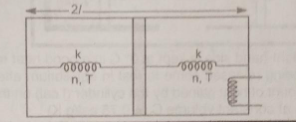Figure shows a container having adiabatic walls and a freely movable separator which is highly conducting. The separator divides the cylinder in two equal parts A and B each containing 2 moles of ideal diatomic gas at temperature 300 K. Now a heater is switched on in part A, find the heat supplied (in kJ) by heater till pressure in part A is double [Take R=253 SI units]
![Figure shows a container having adiabatic walls and a freely movable separator which is highly conducting. The separator divides the cylinder in two equal parts A and B each containing 2 moles of ideal diatomic gas at temperature 300 K. Now a heater is switched on in part A, find the heat supplied (in kJ) by heater till pressure in part A is double [Take R = 25/3 SI units]](https://d10lpgp6xz60nq.cloudfront.net/physics_images/VMC_PHY_XI_WOR_BOK_03_C10_E01_102_Q01.png)
The correct Answer is:25
Since walls are adiabatic heat lost to surrounding = 0
Movable separator is highly conducting ⇒
Temperature remains same in both chambers at all time
⇒ separator doesn’t move or work done by gas =0∴nCvdt=dθ=(2×n)(52R)(2T0−T0) ⇒dθ=25kJ
Similar Questions
The figure shows a container having adiabatic walls and a freely movable separator which is highly conducting. The separator divides the cylinder in two equal parts A and B each containinig 2 mol of ideal monatomic gas at temperature 300K. Now a heater is switched on in part A. Find the heat supplied (in kJ) by the heater till the pressure in part A is doubled. [Take R=253 SI units]
'(##CEN_KSR_PHY_JEE_C15_E01_032_Q20##)'View SolutionA heater coil is cut into two equal parts and only one part is now used in the heater. The heat generated will now be
View Solution
Knowledge Check
- Question 1 - Select One
If a heater coil is cut into two equal parts and only one part is used in the heater, the heat generated will be
AdoubledBfour timesCone-fourthDhalved - Question 2 - Select One
A heater coil is cut into two equal parts and only one part is now used in the heater. The heat generated will now be
Afour timesBdoubledChalvedDone fourth - Question 3 - Select One
A closed and isolated cylinder contains ideal gas. An adiabatic separator of mass m, cross sectional area A divides the cylinder into two equal parts each with volume V0 and pressure P0 in equilibrium Assume the sepatator to move without friction.
Identify the correct statementAThe process is adiabatic only when the piston is displaced suddenlyBThe process is isothermal when the piston is moved slowlyCThe motion is periodic for any displacement of the pistonDThe motion is SHM for any displacement of the piston
An horizontal insulated cylindrical vessel of length 2l is separated by a thin insulating piston into two equal parts as shown. Each part contains n moles of an ideal monoatomic gas at temperature T. The piston is connected to end faces of cylinder with help of two springs each of spring constank k. Initially both springs are in relaxed state. The temperature of left part of cylinder is kept constant by some external means while heat is supplied to right part with help of filament. Answer following questions.

If energy Q is supplied to right part so that the piston moves to left by l/4 then change in internal energy of right part of cylinder isView SolutionAn horizontal insulated cylindrical vessel of length 2l is separated by a thin insulating piston into two equal parts as shown. Each part contains n moles of an ideal monoatomic gas at temperature T. The piston is connected to end faces of cylinder with help of two springs each of spring constank k. Initially both springs are in relaxed state. The temperature of left part of cylinder is kept constant by some external means while heat is supplied to right part with help of filament. Answer following questions.
heat given by left part of cylinder to external arrangement isView SolutionAn horizontal insulated cylindrical vessel of length 2l is separated by a thin insulating piston into two equal parts as shown. Each part contains n moles of an ideal monoatomic gas at temperature T. The piston is connected to end faces of cylinder with help of two springs each of spring constank k. Initially both springs are in relaxed state. The temperature of left part of cylinder is kept constant by some external means while heat is supplied to right part with help of filament. Answer following questions.
temperature of gas in right part in final equilibrium isView SolutionA heat conducting piston can move freely inside a closed thermally isolated cylinder which contains an ideal gas. In equilibrium the piston divides the cylinder in two equal parts, the temperature of the gas being T0. The piston is slowly displaced. Find the temperature of the gas when the volume of one part is n times greater than that of the other part. The adiabatic exponent of the gas is γ.
View SolutionA heater coil is cut into four equal parts and only one parts is now used in the heater. The heat genrated will now be
View Solution
